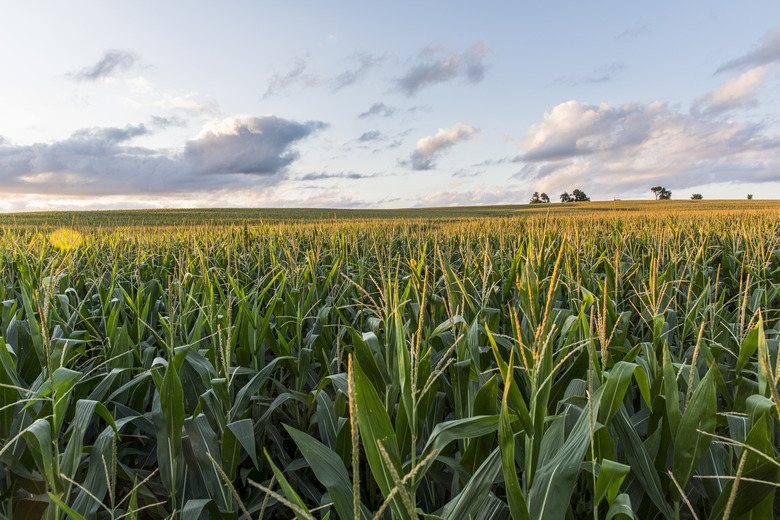How Does Being A Vegetarian Conserve Overall Energy In Trophic Levels?
You've probably heard that being a vegetarian is not only healthier for you, but it's also healthier for the planet. This makes sense on a personal level, as the typical vegetarian diet supplies high amounts of nutrients while lacking the fat and cholesterol of one mostly made of meat. However, is being a vegetarian really better for the planet? It all comes down to the way land is used, the way animals' metabolisms work and the laws of thermodynamics.
Trophic Efficiency
Trophic Efficiency
Think about a food chain. At the bottom of the chain are the primary producers. These are plants, like grasses or wheat, all using photosynthesis to grow. Primary consumers, or herbivores, are the next step up the chain because they eat the plants. Above them on the food chain are secondary consumers, or predators. An organism's place on this chain is its trophic level.
Eating is about getting energy, and that energy initially comes from sunlight that is captured by a plant and then transferred to an herbivore when it eats the plant. A predator then gets that energy when it eats the herbivore.
The problem is that this transfer is inefficient. Energy is needed to survive, and those predators have access to only 10 percent of the energy that the herbivore took in. This is because, on average, the herbivore used 90 percent of the energy it ate to do things like grow and carry out bodily functions.
The Rule of 10 in Ecology
The Rule of 10 in Ecology
Trophic inefficiency has a name, and it's the rule of 10. The rule of 10 is so named because with every link in the food chain, on average only 10 percent ever makes it to the next step. So, of all the energy that plants trap and store, only 10 percent of that energy is available for the herbivores that eat them. In turn, herbivores take that energy and radiate out 90 percent of what they gained, meaning that the predators that eat them only have access to one percent of what was available to the herbivores.
Imagine building a pyramid out of blocks according to this rule. The base, or the first trophic level, can be made of 1,000 blocks, while the next level is only made of 100 blocks. The third tier would only have 10 blocks, and the fourth would only get one block. This is why food chains, at least on land, only have a few links. After a few steps, there's not enough energy left.
Which Organisms Have the Most Energy Available to Them?
Which Organisms Have the Most Energy Available to Them?
The currency of energy content in food is the calorie. A food calorie is actually a kilocalorie in physics, but food calories are what you see on nutrition labels.
In 2014, 90 million acres of corn were planted in the United States. On average that year, a single acre of farmland produced a whopping 15 million calories of corn. An acre of potatoes produces roughly 15 million calories also, and rice produces about 11 million calories. Taking corn as the main example, an acre of corn can meet to energy needs of 7,500 people for one day. It would be a boring diet (and one lacking in crucial nutrients), but this is simplified for a reason.
That acre of farmland, instead of being fed straight to humans, could also be used for animal feed. That same acre would feed 12 hogs that weigh 250 pounds each, and the amount of food that could be eaten from the hogs after processing would add up to nearly two million calories. That's the rule of 10 in action. The corn that would have provided enough calories to feed 7,500 people directly would feed only 1,000 people if they ate the corn-fed pork instead of the corn itself.
Again, this doesn't take nutrition, allergies or other food-related issues into account; it describes the amount of caloric energy available to whatever organism is eating the food. In that sense, organisms that eat plants directly have more energy available to them than organisms that eat other animals.
Are Plant-Based Diets More Energy Efficient?
Are Plant-Based Diets More Energy Efficient?
Humans can get the calories they require daily from animal or plant sources. Because humans aren't typically energetically limited like predators in the wild are, eating more animal-based calories instead of plant-based calories just demands more land and resources in order to make those products.
This doesn't mean you have to become vegetarian or vegan if that lifestyle is not for you. However, in terms of the rule of 10, eating less meat and more plants changes the amount of caloric energy you have access to.
Cite This Article
MLA
Brennan, John. "How Does Being A Vegetarian Conserve Overall Energy In Trophic Levels?" sciencing.com, https://www.sciencing.com/being-vegetarian-conserve-overall-energy-trophic-levels-3342/. 30 September 2021.
APA
Brennan, John. (2021, September 30). How Does Being A Vegetarian Conserve Overall Energy In Trophic Levels?. sciencing.com. Retrieved from https://www.sciencing.com/being-vegetarian-conserve-overall-energy-trophic-levels-3342/
Chicago
Brennan, John. How Does Being A Vegetarian Conserve Overall Energy In Trophic Levels? last modified August 30, 2022. https://www.sciencing.com/being-vegetarian-conserve-overall-energy-trophic-levels-3342/
